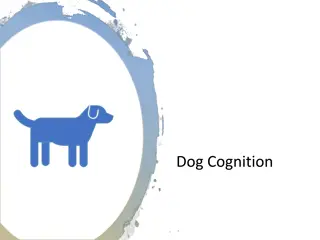Overview of Laboratory Animals and Their Uses in Biomedical Research
Laboratory animals play a crucial role in biomedical research, serving as models for studying various conditions affecting humans and animals. They must thrive in controlled conditions and are used to test hypotheses and drugs. Commonly used lab animals include rodents, lagomorphs, canines, felines,
0 views • 9 slides
Exploring Human Origins: Evolution and Phylogenetic Trees
Delve into the fascinating realm of human origins through an examination of humans and African apes, evidence for evolution, and the construction of phylogenetic trees. Understand the relationships between species, common ancestors, and key evolutionary developments that have shaped the course of hu
4 views • 18 slides
Understanding Primate Characteristics: Movement, Dexterity, and More
Primate characteristics encompass a range of physical traits tailored for their environments, like adept movement abilities and dexterity in their hands and feet for grasping objects. Their unique skeletal structure allows for flexibility and skilled locomotion. Learn about the fascinating features
0 views • 11 slides
Understanding Primate Behavior: Insights into Social Dynamics
Primates, including lemurs, monkeys, apes, and humans, exhibit complex social behaviors such as parental care, communication through language, and conflict resolution strategies. They invest significantly in the upbringing of their offspring, fostering skills essential for survival through play and
0 views • 16 slides
Understanding ChIP-seq Data Analysis in Primate iPSCs
Analysis of ChIP-seq data in primate iPSCs reveals insights into regulatory differences, experimental systems, read subsampling, QC analysis, peak classification, and cross-species comparisons for transcriptional regulation studies. Balanced designs and functional validation of iPSCs contribute to a
0 views • 33 slides
Understanding Color Vision in Primates and Mammals
Explore the fascinating world of color vision in primates and other mammals through trichromatic and dichromatic color vision systems. Discover how dichromats and trichromats perceive colors differently due to the types of color-detecting cells in their retinas. Learn why most mammals are dichromats
0 views • 24 slides
Understanding Zoonotic Hepatitis A Virus Infections
Zoonotic hepatitis A virus infections primarily affect humans and nonhuman primates, with transmission occurring through fecal-oral route. This article delves into the reservoir, mode of transmission, clinical signs, and diagnosis of hepatitis A, shedding light on its impact on both species. Nonhuma
0 views • 22 slides
Understanding Purine Degradation and Gout
Purine degradation pathway involves the breakdown of dietary nucleic acids, mainly from meat, into uric acid through specific enzymatic steps. Excessive uric acid production can lead to conditions like gout and hyperuricemia. Humans excrete uric acid in the urine as the final product, while other an
1 views • 12 slides
Evolutionary Insights from Mitochondrial DNA Analysis in Primates
Studies by Ferris et al. and Cann et al. utilized mitochondrial DNA analysis to understand the evolutionary relationships among apes and humans. The application of parsimony to restriction sites revealed the closest genetic ties between species and proposed an African origin for human colonization.
0 views • 13 slides
Dog Cognition: Understanding the Advanced Cognitive Abilities of Dogs
Exploring the fascinating realm of dog cognition reveals how dogs exhibit advanced cognitive abilities beyond that of many non-human primates. From social learning to strong discrimination learning, contingency reversal, and object manipulation, dogs showcase remarkable intelligence that continues t
0 views • 35 slides
Exploring Human Evolution and Our Connection to Apes
Delve into the fascinating world of paleontology and human evolution through engaging visuals and thought-provoking questions. Discover the similarities and differences between humans and apes, explore the ape family tree, and learn about hominids. From examining foreheads to dental arcades, uncover
0 views • 17 slides
Understanding Olfaction: The Sense of Smell in Animals and Humans
Olfaction, the sense of smell, plays a vital role in animals like dogs and rabbits for environmental warning. Humans and primates, although microsomatics, also rely on smell for pleasure and food enjoyment. The olfactory system, including the olfactory mucosa's histological structure and specialized
0 views • 13 slides
Exploring the World of Mammals
Delve into the diverse world of mammals, characterized by unique features like specialized teeth, hair, and mammary glands. Learn about the different groups of mammals, from primitive monotremes to specialized placental mammals. Witness the fascinating adaptations of marsupials, placentals, and vari
0 views • 20 slides
Understanding Ebola Virus: Information and Prevention Measures
Ebola Virus, a rare and deadly disease caused by infection with one of the Ebola virus strains, can affect humans and nonhuman primates. The disease is primarily transmitted through bodily fluids, contaminated objects, and infected animals. Outbreaks have occurred in various countries, but to date,
0 views • 7 slides
Safety and Pharmacodynamic Activity of Vesatolimod (GS-9620) in HIV-Infected Individuals
Vesatolimod (GS-9620) has shown to be safe and pharmacodynamically active in individuals infected with HIV. Studies demonstrate its potential to eliminate and activate infected CD4 T cells, recruit immune cells like NK cells and macrophages, and work in combination with broadly neutralizing antibodi
0 views • 21 slides
Decentring Collective Action in Internet Activism: A Study on Collective Agency in China
This study explores the concept of collective agency in internet activism within the context of social movements in China. It discusses the role of ICT in virtual collective action, the structural preconditions for collective action, and the shift towards a more decentralized approach to collective
1 views • 16 slides















